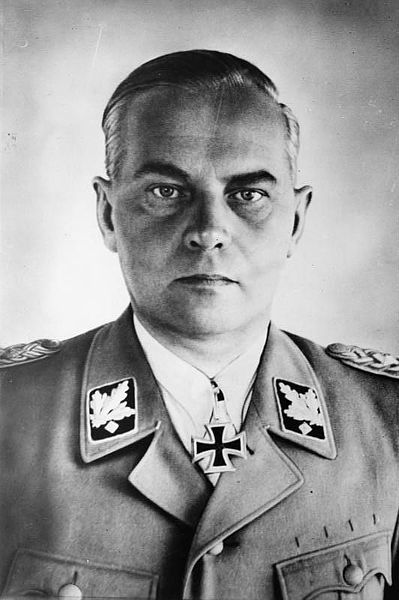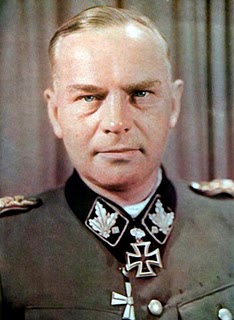<Back to Index>
- Physician Franz Anton Mesmer, 1734
- Painter Carl Heinrich Bloch, 1834
- General der Waffen SS Felix Martin Julius Steiner, 1896
PAGE SPONSOR



Felix Martin Julius Steiner (23 May 1896 – 12 May 1966) was a German Reichswehr and Waffen-SS officer who served in both World War I and World War II.
Steiner ranks as one of the most innovative commanders of the Waffen-SS. He skillfully commanded the SS-Deutschland Regiment through the invasions of Poland, France and the Low Countries. He was then chosen by Himmler to oversee the creation of, and then command the volunteer SS Division, SS-Division Wiking. In 1943, he was promoted to the command of III (Germanic) SS Panzer Corps. On 28 January 1945, Steiner was placed in command of the 11th SS Panzer - Army. His army was part of Army Group Vistula. On 21 April, during the Battle for Berlin, Steiner was placed in command of Army Detachment Steiner.
On 22 April, the Russians outnumbered Steiner's worn out and exhausted
unit by ten to one. Hitler gave orders for Steiner's forces through a
pincer attack to envelop 1st Belorussian Front, advancing from north of
Berlin. Later in the day, Steiner made it plain that he did not have the divisions to do this. On
22 April, at his afternoon situation conference, Hitler fell into a
tearful rage when he realised that his plans of the day before were not
going to be realised. Imprisoned until 1948, Steiner was cleared of all charges of War Crimes and after writing several books, died on May 12, 1966. Felix Martin Julius Steiner was born on May 23, 1896 in Stallupönen, East Prussia. In 1914, on the eve of war, Steiner joined the Prussian Officer Corps as a cadet. During the course of the war, he earned the Iron Cross first and second class and finished the war as an Oberleutnant. After the war, Steiner led a unit of Freikorps in the East Prussian city of Memel. He rejoined the army in 1922 and by 1933 had attained the rank of Major. After the NSDAP takeover, Steiner joined the Reichswehr staff
and began work developing new training techniques and tactics. During
this time he was exposed to the training and doctrines of the Schutzstaffel and Sturmabteilung. He was intrigued by the training techniques of the SS-Verfügungstruppen (SS-VT, precursors to the Waffen-SS),
which placed emphasis on unit cohesion and trust, with an informal
relationship between the enlisted and commissioned ranks. In 1935,
Steiner took command of a Battalion of SS-VT troops, and within a year
had been promoted to SS-Standartenführer and was in command of the
SS-Deutschland Regiment. The
outbreak of war saw Steiner as an SS-Oberführer and still in
charge of the SS-Deutschland. He led his regiment well through the Invasion of Poland and the Battle of France, earning the Knight's Cross of the Iron Cross on 15 August 1940. After the early war campaigns, Steiner was chosen by SS-Reichsführer Heinrich Himmler to oversee the creation of, and then command the new volunteer SS Division, SS-Division Wiking. The Wiking was made up of Non-German volunteers, and at the time of its creation consisted mostly of Dutch, Walloons, and Scandinavians including the Danish regiment Frikorps Danmark. In
the Wiking Division, Steiner created a capable formation from disparate
elements, and he commanded them competently through the many battles in the east from 1941 until his promotion to command of the III (Germanic) SS Panzer Corps. While
there are several incidents documented by historians in which the
division engaged in massacres, the Wiking's official combat record is
clear of any specific War Crimes prosecutions. Steiner said of the Commissar Order "No
rational unit commander could comply with such an Order". He felt that
it was incompatible with soldierly conduct and would result in a
breakdown in military discipline, and that it was incompatible with
giving combat its moral worth. Even if it was on utilitarian grounds,
Steiner felt that the Commissar Order was to be ignored, as detrimental
to good order and discipline. In January 1945, Steiner along with the III (Germanic) SS Panzer Corps was transferred from the Courland Pocket to help with the defence of the German homeland. The III (Germanic) SS Panzer Corps was assigned to Army Group Vistula and put under the new Eleventh SS Panzer Army,
although this army really only existed on paper. Once the Soviets
reached the Oder, the Eleventh SS Panzer Army became inactive and the III
(Germanic) SS Panzer Corps was re-assigned to the German Third Panzer Army as a reserve during the Soviets' Berlin Offensive Operation. During the Battle of Halbe, the first major battle of the offensive, General Gotthard Heinrici, the commander of Army Group Vistula, transferred most of the III SS Panzer Corps's divisions to General Theodor Busse's German Ninth Army. Steiner had always been one of Hitler's
favourite commanders, who admired his 'get the job done' attitude and
the fact that he owed his allegiance to the Waffen SS, not the Prussian Officer Corps. Joseph Goebbels also
praised Steiner. "He is energetic and purposeful and is attacking his
job with great verve," Goebbels wrote on 1 March 1945. By 21 April, Soviet Marshal Zhukov's 1st Belorussian Front had broken through the German lines on the Seelow Heights. Adolf Hitler, ignoring the facts, started to call the ragtag units that came under Steiner's command Army Detachment Steiner (Armeeabteilung Steiner).
An army detachment was something more than a corps but less than an
army. Hitler ordered Steiner to attack the northern flank of the huge salient created by the 1st Belorussian Front's breakout. In conjunction with Steiner's attack, the Ninth Army under General Theodor Busse,
was to attack from the south in a pincer attack. The Ninth Army had
been pushed to south of the 1st Belorussian Front's salient. To
facilitate this attack, Steiner was assigned the three divisions of the
Ninth Army's CI Army Corps: the 4th SS Polizei Division, the 5th Jäger Division, and the 25th Panzergrenadier Division. All three divisions were north of the Finow Canal on the Northern flank of Zhukov's salient. Weidling's LVI Panzer Corps,
which was still east of Berlin with its northern flank just below Werneuchen, was also to participate in the attack. The three divisions from CI Army Corps were to attack south from Eberswalde on
the Finow Canal towards the LVI Panzer Corps. The three divisions from
CI Army Corps were 24 kilometres (about fifteen miles) east of Berlin
and the attack to the south would cut the 1st Belorussian Front's
salient in two. Steiner called Heinrici and informed him that the plan could not be implemented because the 5th Jäger Division and the 25th Panzer Grenadier Division were deployed defensively and could not be redeployed until the II Naval Division arrived
from the coast to relieve them. This left only two battalions of the
4th SS Police Division available and they had no combat weapons. Based on Steiner's assessment, Heinrici called Hans Krebs, Chief of Staff of the German General Staff of the High Command of the Army (Oberkommando des Heeres or
OKH), and told him that the plan could not be implemented. Heinrici
asked to speak to Hitler, but was told Hitler was too busy to take his
call. On
22 April 1945, at his afternoon conference, Hitler became aware that
Steiner was not going to attack and he fell into a tearful rage. Hitler
declared that the war lost, he blamed the generals, and announced
that he would stay on in Berlin until the end and then kill himself. On the same day, General Rudolf Holste was
given what few mobile forces Steiner commanded so that he could
participate in a new plan to relieve Berlin. Holste was to attack from
the north while General Walther Wenck attacked from the west and General Theodor Busse attacked
from the south. These attacks amounted to little and, on 27 April, the
Soviet forces attacking to the north and to the south of Berlin linked
up to the west of the city.
After the surrender, Steiner was incarcerated until 1948. He faced charges at the Nuremberg Trials, but they were all dropped and he was released. He dedicated the last decades of his life to writing his memoirs and several books about the war. He died on 12 May 1966.